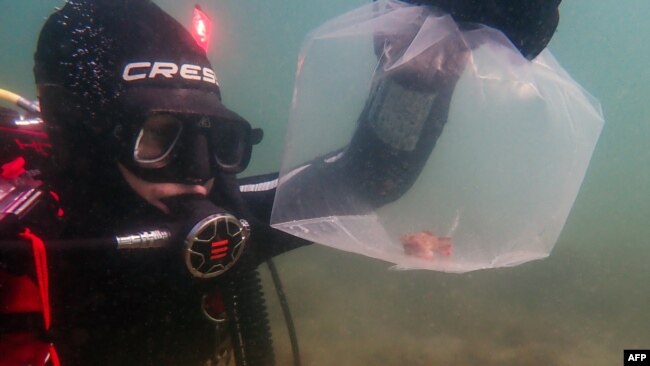해양 폭염이 세계 식량 공급에 영향을 미칠 수 있다는 연구 결과
Study Finds Ocean Heatwaves Could Affect Global Food Supplies
페이지 정보
작성자 By Phil Mercer 작성일 24-02-05 04:38 댓글 0본문

파일 - 2024년 1월 11일에 촬영되어 태즈메이니아 대학의 해양 및 남극 연구소에 의해 1월 31일에 공개된 이 유인물 사진은 호주 태즈메이니아 주 앞바다에서 안전 조치의 일환으로 심각한 멸종 위기에 처한 붉은 손 물고기가 조치되는 것을 보여줍니다.
FILE - This handout photo taken on Jan. 11, 2024, and released on Jan. 31 by the University of Tasmania's Institute for Marine and Antarctic Studies shows a critically endangered red handfish being taken as part of a safeguard measure from waters off Australia's Tasmania state.
시드니 —
SYDNEY —
새로운 연구는 해양 폭염이 생태계와 잠재적으로 세계 식량 공급을 방해하면서 해양 먹이 사슬의 기반을 바꾸고 있다는 것을 발견했습니다.
A new study finds that marine heatwaves are changing the base of the marine food chain, disrupting ecosystems and potentially global food supplies.
호주의 국립 과학 기관인 CSIRO가 주도한 조사의 연구원들은 그들의 연구가 세계적인 의미를 가지고 있다고 말합니다.
Researchers in the investigation led by Australia’s national science agency, CSIRO, say their work has global implications.
이 연구는 해양 먹이 사슬의 맨 아래에 위치한 미생물들의 건강을 관찰했습니다. 이 조사는 12년에 걸친 장기 프로젝트의 일부입니다.
The study monitored the health of microorganisms that lie at the base of the marine food chain. The survey is part of a long-term project spanning 12 years.
작은 식물성 플랑크톤 종은 더 큰 동물들이 쉽게 섭취하지 않는 더 작은 세포를 발달시켰습니다. 연구원들은 이것이 잠재적으로 "먹잇감 사슬 전체에 걸쳐 근본적인 변화"를 가져올 수 있다고 믿습니다
Tiny phytoplankton species developed smaller cells that are not easily consumed by larger animals. Researchers believe this could potentially have “profound changes all the way up the food chain.”
또한 해양 생태계가 탄소를 흡수하거나 격리하는 능력과 어족 자원의 크기에도 영향을 미칠 수 있습니다.
There could also be impacts on the ability of marine ecosystems to absorb - or sequester - carbon and the size of fish stocks.
이 연구의 주요 필자인 마크 브라운(Mark Brown)은 VOA에 이번 연구가 광범위한 영향을 끼치고 있다고 말합니다.
The study’s lead author Mark Brown tells VOA that the study has far-reaching implications.
"이것은 정말로 세계적인 문제입니다. 전 세계의 모든 곳이 폭염을 경험하고 있습니다. 홍해와 같은 가장 따뜻한 곳들도 장기 평균보다 기온을 점점 더 높게 상승시키고 있습니다," 라고 브라운이 말했습니다. "북극과 남극과 같은 곳들은 해양 폭염을 일으킬 수 있고, 그러한 큰 극지 생태계에 어떤 변화가 생기면 세계 식량 비축량에 상당한 영향을 미칠 것이기 때문에 연구가 정말로 중요한 곳일 수도 있습니다."
“This really is a global issue. Everywhere around the world is experiencing heatwaves. Even the warmest places like the Red Sea are pushing their temperatures higher and higher than the longterm average," Brown said. "Places like the Arctic and the Antarctic can have marine heatwaves and those might be the places where it is really important to study because any changes to those large polar ecosystems will really have (a) significant impact on the global food stocks.”
해양 폭염은 비정상적으로 따뜻한 바닷물을 장기간 포함합니다.
Marine heatwaves involve extended periods of abnormally warm ocean water.
과학자들은 그들이 물고기, 산호초, 다시마 숲을 포함한 해양 생물에 중대한 영향을 미칠 수 있다고 경고합니다.
Scientists warn they can have significant impacts on marine life, including fish, coral reefs and kelp forests.
영연방 과학 산업 연구 기구의 연구의 기반은 2015년부터 2016년까지 태즈메이니아 섬 주에서 떨어진 태즈메이니아 해에서 발생한 해양 폭염이었습니다.
The basis of the research by the Commonwealth Scientific and Industrial Research Organization was a marine heatwave in the Tasman Sea off the island state of Tasmania in 2015 to 2016.
CSIRO 팀은 이러한 극단적인 조건들이 북쪽으로 1,000 킬로미터 떨어진 훨씬 더 따뜻한 바다에서 발견되는 것들과 비슷하게 "미생물 군집을 변화시켰다"는 것을 발견했습니다.
The CSIRO team found that the extreme conditions “transformed the microbial community” to resemble those found in far warmer waters 1,000 kilometers to the north.
CSIRO팀은 기후변화로 인해 해양 폭염의 영향이 심화되고 있으며, 이는 엘니뇨 패턴을 비롯한 자연적으로 발생하는 기상 현상의 영향도 받을 수 있다고 밝혔습니다.
The CSIRO team says that climate change is intensifying the impact of marine heatwaves, which can also be influenced by naturally occurring weather phenomena, including the El Niño pattern.
브라운은 그들이 연구하는 유기체들은 작지만, 그들의 중요성은 매우 크다고 말합니다.
Brown says while the organisms they study are small, their importance is huge.
"그것들은 아주 작아서, 당신은 육안으로 볼 수 없습니다"라고 그는 말했습니다. "따라서, 이 모든 것들은 보이지 않습니다. 마치 당신의 장내 미생물들이 당신의 몸 안에 건강한 생태계를 갖고 영양소를 에너지로 바꾸는 것을 가능하게 하듯이, 바다에서도 같은 과정들이 발생하지만, 연구하는 것은 매우 어렵습니다. 그래서, 무엇이 있는지 정말로 분석하기 위해 게놈 기술, DNA 염기서열 분석 등을 사용해야 하는 이유입니다."
“They are minuscule, and you cannot see them with the naked eye," he said. "So, all these things are invisible. Just like your gut microbes enable you to have a healthy ecosystem in your body and turn nutrients into energy etcetera, the same processes occur in the ocean, but it is very difficult to study. So, this is why we need to use genomic techniques, DNA sequencing etcetera in order to really analyze what is there.”
CSIRO 연구 결과는 네이처스 커뮤니케이션 바이올로지 저널에 발표되었습니다.
The CSIRO findings have been published in the journal Nature’s Communications Biology.
출처 : VOANews
댓글목록 0
등록된 댓글이 없습니다.

















